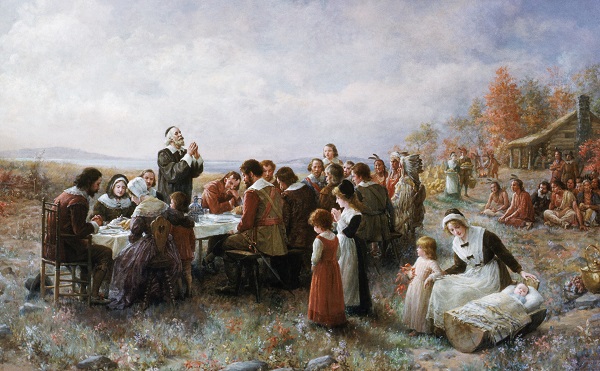
“May not and ought not the children of these fathers rightly say: ‘Our fathers were Englishmen which came over this great ocean, and were ready to perish in this wilderness, but they cried unto the Lord, and He heard their voice and looked on their adversity…’
Let them, therefore, praise the Lord, because He is good, and His mercies endure forever, Yea, let them which have been redeemed of the Lord, show how He hath delivered them from the hand of the oppressor. When they wandered in the desert wilderness out of the way and found no city to dwell in, both hungry, and thirsty, their soul was overwhelmed in them. Let them confess before the Lord His lovingkindness, and His wonderful works before the sons of men.” (William Bradford, Of Plymouth Plantation)
What Did the Pilgrims Eat on the First Thanksgiving?
Many dishes served during modern Thanksgiving meals were not present at the first Thanksgiving (sorry, no green bean casserole). The colonists didn’t have potatoes, nor did they have the butter or flour necessary for making pies. The Pilgrims hadn’t even built their first oven by the time of the first Thanksgiving. They might have served cranberries, but only for color or tartness, instead of as a sweet sauce.
Neither Bradford nor Winslow reveal in their writings what they actually served at the first Thanksgiving meal, besides foul and deer. However, we can make educated guesses based on the types of food they often wrote about such as mussels, lobsters, grapes, plums, corn, and herbs.
There is no actual proof that the colonists ate turkey at the feast. Turkey did not truly become associated with Thanksgiving until the 1840s when an editor of a ladies’ magazine came across Edward Winslow’s writings about the feast.
When this editor read Winslow’s writings, she decided to bring this historic celebration back to life. Up until then, Thanksgiving was only a regional New England holiday and wasn’t celebrated across the country like it is today. The editor began publishing recipes and articles about the feast.
Shortly after this, the editor discovered Bradford’s book. It had gone missing during the Siege of Boston in 1775 and resurfaced in the library of Fulham Palace in London that year. She focused her attention on a brief sentence Bradford had written about the colonists’ hunt for wild turkeys:
“And besides waterfowl there was great store of wild turkeys, of which they took many, besides venison, etc.”
The editor began publishing articles about Thanksgiving dinners with roasted turkey, and before long, the two became synonymous.
Many people believe Thanksgiving feasts became a regular tradition for the Pilgrims. Whether this is true or not is unclear. There are no other accounts of the Pilgrims holding any more harvest celebrations after 1621. It is possible that the feasts happened, but if they did, one recorded it.
Why Is It Called Thanksgiving?
The feast celebrated by the Pilgrims in 1621 was never actually called “Thanksgiving” by the colonists. However, in July 1623, the Pilgrims did hold what they specifically called a Thanksgiving. The Pilgrims set this day aside for prayer, fasting, and giving of thanks. It certainly not a stretch to see that thanksgiving came from giving thanks.
Over the years, the names of the two events became intertwined. By the late 1600s, many individual colonies and settlements began holding “Thanksgiving feasts” during the autumn months.
When Did Thanksgiving Become a National Holiday?
The Continental Congress declared the first national Thanksgiving on December 18, 1777 (click here to read the proclamation). Then in 1789, George Washington declared the last Thursday in November to be a national Thanksgiving as well. (Click here to read the proclamation.) These were merely declarations, however, and not official holidays. Future presidents did not continue the Thanksgiving declaration.
Thanksgiving did not become a national holiday until 1863 when President Abraham Lincoln supported legislation to make it an official holiday. (You can read his proclamation here.) This is especially poignant when we remember that America was in the midst of the Civil War at that time. President Lincoln hoped the new holiday would unify the bitterly divided country. The institution of the holiday was a success, and Thanksgiving has continued ever since.
In every thing give thanks: for this is the will of God in Christ Jesus concerning you. (1 Thessalonians 5:18)
Sources:
“Primary Sources for the First Thanksgiving at Plymouth.” Pilgrim Hall Museum, www.pilgrimhall.org
Santino, Jack. All Around the Year: Holidays and Celebrations in American Life. University of Illinois Press, 1994.
Bradford, William and Winslow, Edward. Mourt’s Relations: Or the Journal of the Plantation at Plymouth. John Bellamy, 1622.
